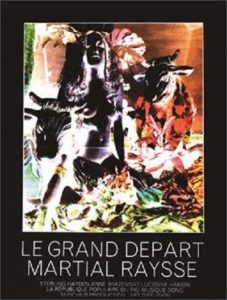 Not a good movie, though a prime example of audacious, rule-breaking cinema. It’s a 1972 French film shown almost entirely in negative exposure, which in itself makes it worth a watch.
Not a good movie, though a prime example of audacious, rule-breaking cinema. It’s a 1972 French film shown almost entirely in negative exposure, which in itself makes it worth a watch.
LE GRAND DEPART was the only feature directed by the famed French painter and sculptor Martial Raysse. In keeping with the revolutionary spirit of the time, LE GRAND DEPART has no plot to speak of and appears to have been largely made up on the spot. It shares a kinship with such films as BEGOTTEN (1990) and the X-rated short THE OPERATION (1995), both of which experimented with negative exposure (and far more effectively).
For decades LE GRAND DEPART was thought a “lost” film, but in late 2008 it made its DVD debut (in France), to alternately enchant and disappoint viewers anew.
The opening credits are spoken over pictures of an idyllic beachfront landscape—but then the camera pulls back to reveal those pictures as designs on a guy’s shirt. Said guy is watching footage of political demonstrations on his TV, while outside a weird dude in a cat mask rides by on a bike.
We follow the cat man into a bizarre fantasy universe presented in negative exposure that reverses color values (black is white and vice versa) and written words. The cat man steals a car and then picks up a young girl he promises to take to “Heaven.” Heaven turns out to be a country chateau inhabited by several more animal mask wearing weirdoes.
There’s also a hippie cult frolicking in the woods nearby. The cult’s leader is an intense English speaking guru who prophecies a “Grand Departure” that will liberate his followers from their Earthly concerns.
Somewhere in here we learn the cat man represents death, as everyone he meets dies soon afterward—if he doesn’t do the killing himself. An example of this occurs when he callously molests a woman on a country road and leaves her for dead.
The cat man winds up on a “raft of freedom” manned by the guru and his followers. The raft becomes a sort of interstellar flying carpet that whisks them all through the cosmos. The trip is fun at first, with the cultists frolicking and playing ball with the Earth(!), but it eventually degenerates into a mass orgy…and the film finally returns to normal exposure.
This dull, formless film is far from the magical phantasmagoria Martial Raysse appears to have been striving for, but it does have its moments. The negative exposure works wonders, transforming drab Parisian locations into exotic dreamscapes. Of course it can’t do much for the camerawork, which is loose and amateurish; without the visual heightening this would likely play like an undistinguished home movie. Nor is the acting anything much; the only performer who makes any impression is Sterling Hayden as the cult leader (how Raysse convinced Hayden to appear in this film I’ll never figure out).
Yet those interested in the unusual will definitely want to check out LE GRAND DEPART. It provides an eye-opening look at just how staid and predictable most movies are (comparatively speaking) and suggests a tantalizing possibility: imagine how this film might play were it made by a real filmmaker!
Vital Statistics
LE GRAND DEPART (THE GRAND DEPARTURE)
Sunchild Productions
Director/Screenplay: Martial Raysse
Cinematographer: Jean-Jacques Flori
Editing: Monique Giraudy, Martine Kalfon
Cast: Sterling Hayden, Anne Wiazemsky, Gilles Raysse, Lucienne Hamon, Alexandre Raysse, Jackie Raynal
